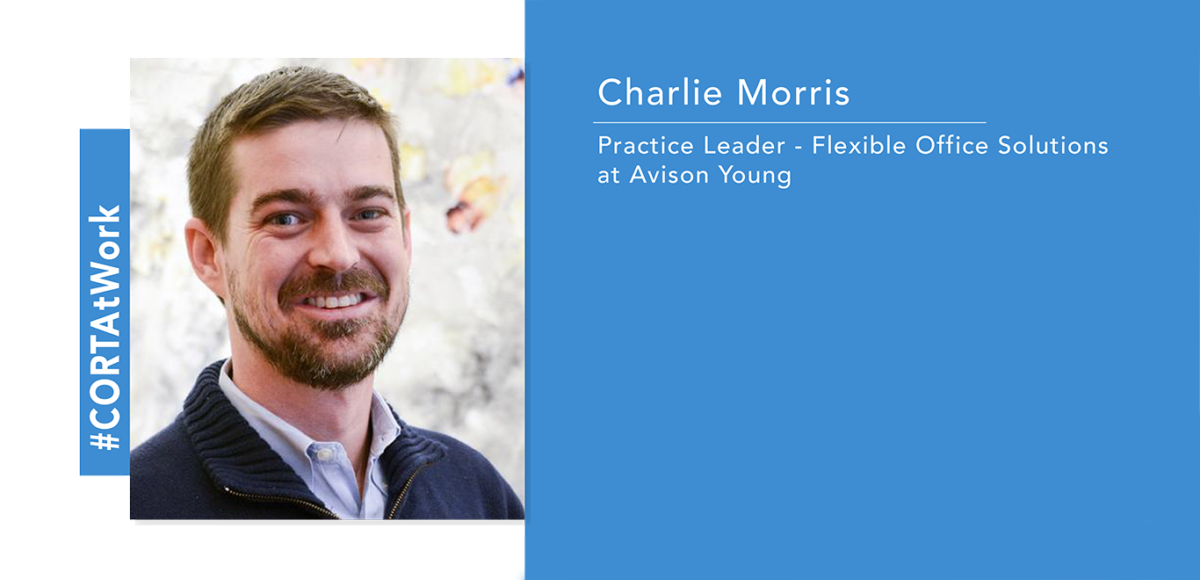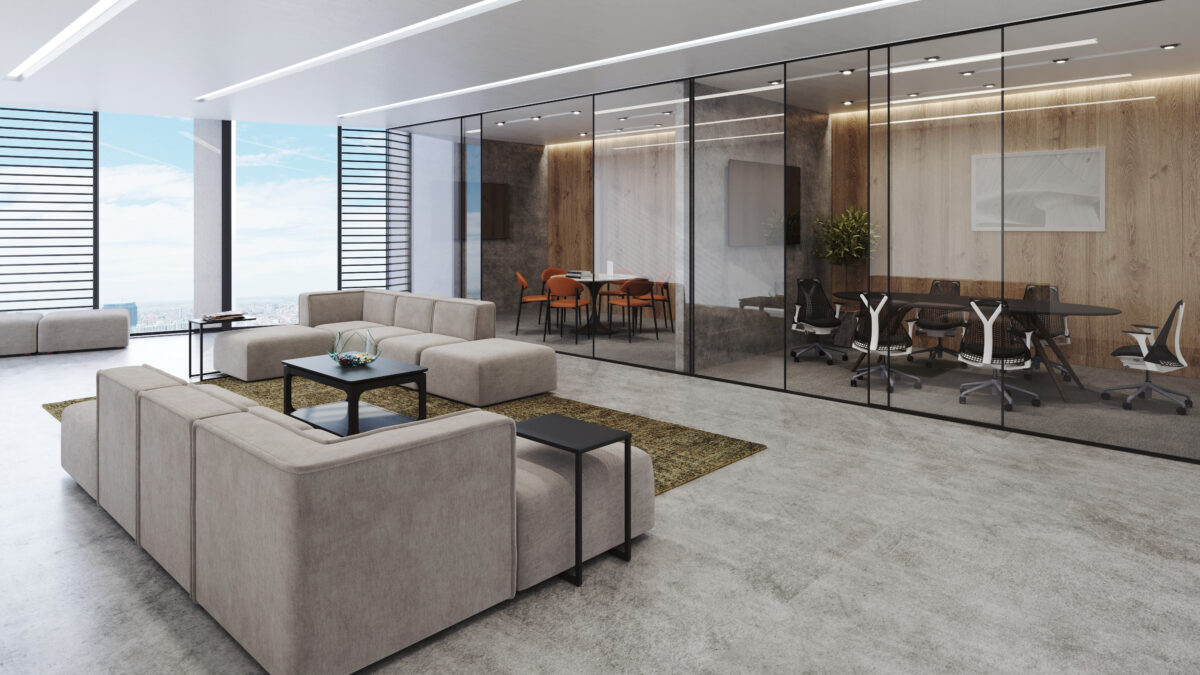This article is part of the “CORT Workplace Talk” series where Melanie Jones, CORT’s National Director, CRE Partnerships, sits down with thought leaders in commercial real estate to discuss advancements, insights, and trends within the industry. Sit back and learn more about CRE and how CORT Furniture Rental can benefit your organization.
My team asked me why I wanted to interview Charlie Morris in this segment. I had to stop for a moment and reflect on the question. I have a hundred reasons I could share but to distill it down; it’s because I have watched him work so hard in earning his position leading the Flexible Office Solutions team at Avison Young.
Follow him or those on his team, and you’ll see them out front daily; speaking, writing, educating, challenging, questioning, and thinking about the future of flexible space in the current disrupted world of commercial real estate. Charlie is a friend to me and many. Read on and see why.
MJ: It was just a few years ago that we met, enjoyed coffee and conversation in Midtown Atlanta. It seems like so long ago, though! We’ve both undertaken new assignments since then, and I appreciate your willingness to share ideas in this CORT Workplace Talk!
You’ve had a few stops along the career journey. At what point did you understand the importance of flexible space in the overall occupier portfolio? You’ve had a vision for a while now.
CM: I was an office tenant rep for the first 12+ years of my career, starting my career at Colliers and joined Avison Young (AY) as a Principal in the Dallas office in 2014. Before joining AY, I had really begun to acknowledge the commoditization of the brokerage industry. When I joined AY, I disclosed to leadership that I wanted to transition my practice to focus more on the business’s disruptive sides, the emerging flexible sector, and the property technology (PropTech) ecosystem. I continued supporting some of my legacy clients, but anything new was pursuing my passion for becoming part of the disruption versus being disrupted.
One of the transitional moments in my career came from my representation of LiquidSpace who sought to leverage their altSpace offering to support a flexible requirement on Salesforce’s behalf. My task included finding a building/owner who would lease space to LiquidSpace. Then license that space back to Salesforce and deliver a specific kit of parts, including furniture, fixtures, equipment & technology solution package customized to their specific needs.
It went against everything I had learned about how the “market” was supposed to work. This transaction provided the ability to see a different type of enterprise demand along with the operational and financial benefits derived from a flexible solution benefiting both the occupier and owner.
Less than a year later, I worked in-house at LiquidSpace, which I now call my flexible MBA. I engaged with institutional owners, flexible operators, enterprise occupiers, and the broader brokerage community in this role. In this period, I learned that no matter how bullish I was on our technology and product mix, no one product/solution worked for every company. I wanted to figure out a role where I could leverage everything that I had learned and get into a position to engage with all the various products and solutions available to support my client’s unique needs.
Instead of continuing to put a square peg into a round hole, I resigned in the second quarter of 2019, and Mark Rose, Avison Young’s CEO, asked me to come back to AY to create our flexible solutions practice.
MJ: You have assembled a fantastic team of heavy hitters in the industry. What attracted this talented group to your flexible solutions practice at AY?
CM: I feel lucky that we have been able to bring in some talented and passionate professionals to our team. Each of them has a unique background, including some with roles at legacy brokerage companies before entering the flexible industry. I wish I could provide details around each of their experiences. Examples of recent roles within the flexible ecosystem include IWG, Convene, Serendipity Labs, Knotel, Instant Office, Carr Companies, etc. Most joined from a position where they were pushing specific products/solutions, and each of them appreciated our vision of delivering a service-based vs. product-based delivery model.
We are a vertically integrated team supporting the enterprise occupier, flexible operator, and institutional owner community. Because we operate as a single unit, we can feed off our respective networks, experiences, and insight to provide elevated advisory services focused on the flexible office economy.
Our agnostic position allows us to leverage any/all products or solutions available in the market to satisfy our client’s bespoke needs. Unlike our competitors, we are not sinking millions into developing and building out our own products. I count my blessings every day to have this group of subject matter experts.
MJ: You are an extremely passionate individual, Charlie. What part of the mission excites you most? If we begin with the end in mind, what do you see unfolding?
CM: My passion comes from the excitement of being a change agent within our company and the industry as a whole as we explore different ways to operate within an industry primed for disruption. I wish I could tell you precisely what the end looks like, but I don’t see “an end” as there are always new products and services which will emerge to create more financial savings and operational efficiency. We are seeing more willingness to adapt to the changes upon us. Until the capital markets acknowledge the occupier demand for flexible workspace at scale, we will be slow to adapt.
I hope that as the next phase of office buildings begins to trade hands, we will see underwriting in the office sector shift away from the current valuation standards, which only place value on long-term leases. Over the past three to five years, a dramatic change has occurred, but the capital markets need to adapt further to reach the ultimate scale. I believe that this will begin to unfold over the next three to five years as owners and their lenders acknowledge the demand for flexible solutions as long-term leases begin to expire.
MJ: As your team meets with clients, what is the overall feeling about disruption? Is there more of a sense of concern and fear, or do you see open-mindedness towards change?
CM: Obviously, there are still many refusing to look beyond the status quo, but I would say most occupiers and owners we are engaged with acknowledging changes are upon us. Covid has definitively shifted people’s perspective away from the legacy mentality of productivity can only occur at a dedicated desk within a centralized office’s confines.
While more clients are willing to embrace these changes, we find that most have little insight into the breadth and depth of products and solutions available in the market. We find that most take a reactive buying position instead of formulating their own portfolio or asset management strategy before proactively approaching those partners that can support their overall vision. We approach each client from an advisory position instead of jumping straight into transactional conversations.
MJ: How we utilize space is in the midst of disruption. What are your thoughts on the road ahead?
CM: In short, it will take a couple of years for the industry to get past our legacy portfolio management strategies and transition away from the current models, which the occupier community has acknowledged is an issue. We’ve found that pre-pandemic workspace was utilized on average 50% of the time. Mid pandemic, we see only a fraction of that (+/- 10%), which is why Avison Young created the X-Factor, a journey we help navigate them through to accelerate the human experience within a portfolio management strategy of the future.
Before the occupier community can implement a more innovative portfolio management strategy on any level of scale, we must first assist these corporations in disposing of this excess underutilized, currently underway. It will take time, no doubt, but as stated in a recent blog, For commercial real estate brokers, peak success resides in flexible futures; I made a fairly bold statement but one that I genuinely believe to be true.
I stated, “if both the institutional owner and brokerage communities acknowledge the opportunities available in the market, leverage available flexible solutions and technology appropriately, we could be facing the last down cycle where we have this amount of sublease space on the market.”
Once disposition efforts on underutilized space are complete, creating and implementing a decentralization plan aligned with an occupier’s unique financial, operational and cultural needs will be critical. In this new world, clients will not be forced to commit to as many long-term/fixed (“Core”) leases to support their portfolio strategy needs and create operational agility to adapt to the rapidly changing business environment.
We expect enterprises to commit to smaller spaces within these Core locations as organizations will accommodate even more full-time employees operating out of the same space. Core locations will be where companies focus on their cultural initiatives and become the collaboration hubs for team-based activity, meetings, and event spaces instead of focusing on static desk-based activity.
Some people will still use the central office for day-to-day work, but we expect different departments, teams, and individuals to utilize the office on pre-determined schedules, drastically reducing dedicated desks. All this translates to less of a need for long-term space. The balance of the workspace options made available to employees can be supported by leveraging flexible workspace solutions and mobility solutions which will become even more readily available in the years to come.
“If companies adopt a Core + Flex portfolio management strategy in the future, underutilized space will be dramatically reduced and with that comes operational efficiency and financial savings along with providing workplace optionality allowing companies to recruit and retain talent.”
As an industry, we need to embrace the disruptive changes upon us, look beyond the legacy processes, and fully leverage the emerging products and solutions available today.
MJ: Obviously, data and technology are more important than ever before. In your opinion, what’s critical about the future and the use of data?
CM: At Avison Young, we are big believers in big data, and we believe that actual value creation comes from how we absorb and translate this data to support our clients’ objectives. We have some exciting technology products created by our innovation and consulting divisions, and we leverage these tools daily. To dive deeper, I decided to gather thoughts from my colleague, John Sikaitis, Avison Young’s Chief Innovation Officer, on this topic.
JS: Commercial real estate routinely preaches transparency in its characterization of markets, and yes, there is data everywhere. However, data assets spread everywhere create market inefficiency and often opaqueness in decision-making across the brokerage industry and the occupier and investor community. Prior to two years ago, when social media dramatically exponentialized data, 95% of data globally was stored on paper. According to Avison Young, in commercial real estate, that remains the industry’s preference and thus the norm with that statistic in commercial real estate likely hovering closer to 98%.
In recent years, tens of billions of capital have flowed into PropTech, yet market inefficiency remains as technology has been proposed and even delivered, but not embraced meaningfully; thus, data assets have not scaled.
Other industries have seen similar patterns, and we are, as an industry, beginning to experience this. Before the industry speaks of AI, it needs BI, and before BI, it needs a constant focus on data, from everyone, across the life cycle. That part is slowly beginning to happen. From developers to investors to occupiers to their service providers and consultants working alongside them, entities across the industry are finally starting to organize their individual data assets.
Once individual entities get their own data house in order, they will demand more from outside their home, meshing in big data not on paper but digitally from the outside, making them more efficient and thus markets more transparent. This could open dialogue to the concept of data partnerships across peers in the industry, something that in commercial real estate has never been embraced.
You have so many powerful thoughts to share so we will publish part two of this conversation next week. Till then.
About Charlie
Charlie is the leader of Avison Young’s U.S. Flexible Office Solutions (FOS) practice with a mandate to oversee the management and development of the company’s FOS practice in the U.S. and to expand the practice across the globe. Prior to his role with Avison Young, Charlie was the Director of Business Development for LiquidSpace, a property-technology startup company that supports the flexible-office economy. He has also held senior vice-president and vice-president positions with Cassidy Turley and Colliers International, specializing in office tenant representation. Since entering the commercial real estate industry as a broker in 2006, he has consulted on behalf of large Fortune 500 companies, private firms, and fast-growing startups.
About Melanie
Melanie Jones is responsible for educating, supporting, and building relationships with commercial real estate teams across the US in support of CORT’s Furniture-as-a-Service™ model. A mission-driven leader who brings the necessary energy and innovation to support change in the way furniture is utilized in buildings and the workplace.






